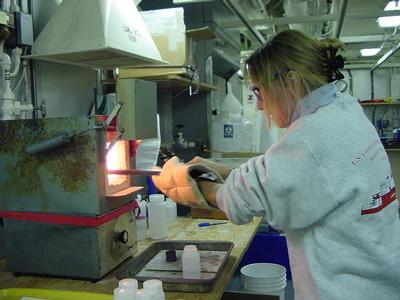12 August, 2001
A Rocky Road adams journal 08/12/01
Last night we broke some serious ice. Around 10:00pm, just at my bedtime,
we hit an area that was heavily iced over, and my night became most
uncomfortable. When the ship encounters such barriers, it tries to break
through it. It has 4 engines, 2 of which are normally in use. A third
engine may be required for more power on larger ice floes, which helps the
ship to proceed with more force. If this doesn't break the ice, the ship
will back up and try again. Sometimes it takes several tries to break
through. This was the case last night, and I didn't sleep a wink. Cabinets
kept flying open and an ironing board flew across the room. It was quite a
ride!
Today we begin our intensive rock collection program. Up to now, we have 7
completed dredges. We have used up all of the space in the lab to put the
rocks collected from these dredges. Therefore, we must move them into
well-labeled buckets to take back to the US for scientists to study. We
will end up with half of the rocks, and the German scientists will end up
with the other half. The same will go for the samples collected on the
Polarstern.
There are several scientists on board who are too anxious to wait until we
get back to begin the analysis of the rocks we've collected. They are
taking the glassy obsidian, referred to as "glass" and analyzing its
chemical properties. It is a long process that begins with picking pieces
of this volcanic glass off of the basalt, which involves tweezers and a good
eye. Then the glass is placed under a microscope and only clean/fresh
looking glass is selected (the ocean water can cause weathering on the glass
and this would an give incorrect analysis of it). This nice glass is then
melted in a small furnace. When it is a red-hot liquid, it is removed from
the furnace and immediately poured into nitric acid to form a solution. The
solution is then put through a chemical analysis and the results lead to
conclusions about the melting processes (such as how fast or slow the mantle
melted to form the rocks that we're collecting).
The weather continues to be very pleasant here in the Arctic. We have
neared Greenland and more wildlife is being spotted. Many polar bear tracks
are visible in the snowy ice, and seals are becoming a common sight.
Statistics:
Latitude: 82 52 N
Longitude: 7 03 W
Air temperature: 34 F
Water temperature: 29 F

Kerstin opens the furnace door to remove the melted volcanic glass. She will then pour it into nitric acid to form a solution for analysis. <>

Paul picks through the glass (obsidian) to obtain the best samples for analysis. <>
Contact the TEA in the field at
.
If you cannot connect through your browser, copy the
TEA's e-mail address in the "To:" line of
your favorite e-mail package.
|
